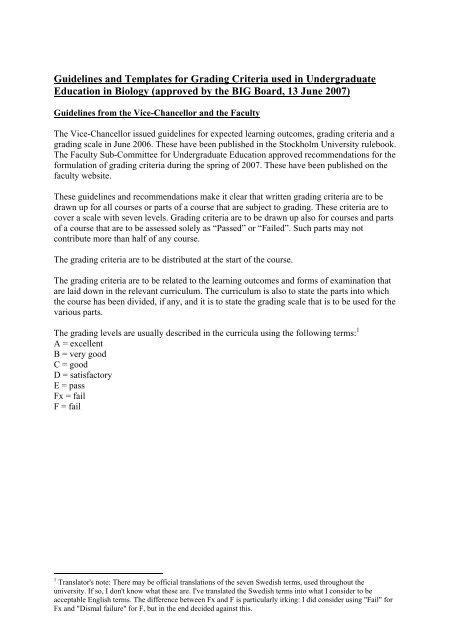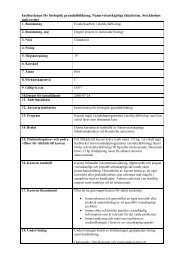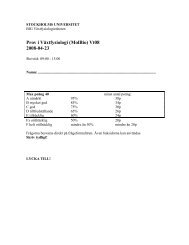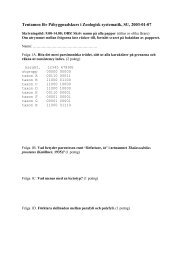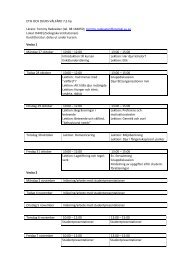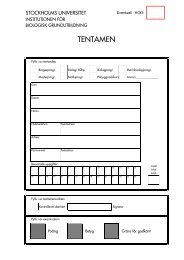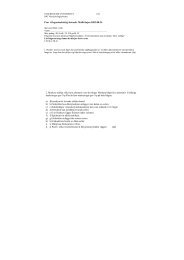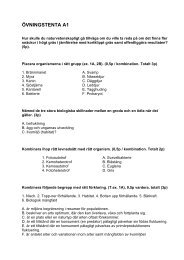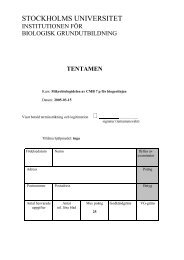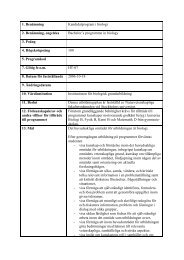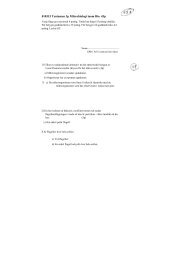Guidelines and Templates for Grading Criteria used in ... - BIG
Guidelines and Templates for Grading Criteria used in ... - BIG
Guidelines and Templates for Grading Criteria used in ... - BIG
You also want an ePaper? Increase the reach of your titles
YUMPU automatically turns print PDFs into web optimized ePapers that Google loves.
<strong>Guidel<strong>in</strong>es</strong> <strong>and</strong> <strong>Templates</strong> <strong>for</strong> <strong>Grad<strong>in</strong>g</strong> <strong>Criteria</strong> <strong>used</strong> <strong>in</strong> Undergraduate<br />
Education <strong>in</strong> Biology (approved by the <strong>BIG</strong> Board, 13 June 2007)<br />
<strong>Guidel<strong>in</strong>es</strong> from the Vice-Chancellor <strong>and</strong> the Faculty<br />
The Vice-Chancellor issued guidel<strong>in</strong>es <strong>for</strong> expected learn<strong>in</strong>g outcomes, grad<strong>in</strong>g criteria <strong>and</strong> a<br />
grad<strong>in</strong>g scale <strong>in</strong> June 2006. These have been published <strong>in</strong> the Stockholm University rulebook.<br />
The Faculty Sub-Committee <strong>for</strong> Undergraduate Education approved recommendations <strong>for</strong> the<br />
<strong>for</strong>mulation of grad<strong>in</strong>g criteria dur<strong>in</strong>g the spr<strong>in</strong>g of 2007. These have been published on the<br />
faculty website.<br />
These guidel<strong>in</strong>es <strong>and</strong> recommendations make it clear that written grad<strong>in</strong>g criteria are to be<br />
drawn up <strong>for</strong> all courses or parts of a course that are subject to grad<strong>in</strong>g. These criteria are to<br />
cover a scale with seven levels. <strong>Grad<strong>in</strong>g</strong> criteria are to be drawn up also <strong>for</strong> courses <strong>and</strong> parts<br />
of a course that are to be assessed solely as “Passed” or “Failed”. Such parts may not<br />
contribute more than half of any course.<br />
The grad<strong>in</strong>g criteria are to be distributed at the start of the course.<br />
The grad<strong>in</strong>g criteria are to be related to the learn<strong>in</strong>g outcomes <strong>and</strong> <strong>for</strong>ms of exam<strong>in</strong>ation that<br />
are laid down <strong>in</strong> the relevant curriculum. The curriculum is also to state the parts <strong>in</strong>to which<br />
the course has been divided, if any, <strong>and</strong> it is to state the grad<strong>in</strong>g scale that is to be <strong>used</strong> <strong>for</strong> the<br />
various parts.<br />
The grad<strong>in</strong>g levels are usually described <strong>in</strong> the curricula us<strong>in</strong>g the follow<strong>in</strong>g terms: 1<br />
A = excellent<br />
B = very good<br />
C = good<br />
D = satisfactory<br />
E = pass<br />
Fx = fail<br />
F = fail<br />
1 Translator's note: There may be official translations of the seven Swedish terms, <strong>used</strong> throughout the<br />
university. If so, I don't know what these are. I've translated the Swedish terms <strong>in</strong>to what I consider to be<br />
acceptable English terms. The difference between Fx <strong>and</strong> F is particularly irk<strong>in</strong>g: I did consider us<strong>in</strong>g "Fail" <strong>for</strong><br />
Fx <strong>and</strong> "Dismal failure" <strong>for</strong> F, but <strong>in</strong> the end decided aga<strong>in</strong>st this.
<strong>BIG</strong>’s <strong>Guidel<strong>in</strong>es</strong><br />
• <strong>Grad<strong>in</strong>g</strong> criteria are to be drawn up by the teacher responsible <strong>for</strong> the course <strong>in</strong><br />
collaboration with the director of studies.<br />
• A student must achieve pass grades <strong>for</strong> all parts of a course, <strong>in</strong> order to pass the course<br />
as a whole. If a course consists of several parts that are <strong>in</strong>dividually assessed on a<br />
seven-po<strong>in</strong>t scale, the overall grade <strong>for</strong> the course is to be set as specified by the rules<br />
<strong>in</strong> Appendix 1.<br />
• In cases <strong>in</strong> which the per<strong>for</strong>mance of students is measured as po<strong>in</strong>ts, the lower limits<br />
<strong>for</strong> the various grades will be as follows (expressed as percentages of the maximum<br />
po<strong>in</strong>ts available):<br />
A 95 %<br />
B 85 %<br />
C 75 %<br />
D 65 %<br />
E 60 %<br />
Fx 50 %<br />
F below 50 %<br />
• Both Fx <strong>and</strong> F are “Fail”, <strong>and</strong> the student must resit the complete exam<strong>in</strong>ation. This<br />
means, there<strong>for</strong>e, that the grade Fx is not to be regarded as “Approved, subject to<br />
supplementary work”. The concept of “supplement<strong>in</strong>g” a grade is not to be <strong>used</strong><br />
except <strong>in</strong> exceptional cases where exceptional cause can be shown.<br />
• <strong>BIG</strong> has published some templates <strong>for</strong> grad<strong>in</strong>g criteria (Appendix 2). These templates<br />
are <strong>in</strong>tended to be <strong>used</strong> <strong>for</strong> different types of course <strong>and</strong> different types of <strong>for</strong>m of<br />
exam<strong>in</strong>ation. Template 1 is <strong>in</strong>tended to be <strong>used</strong> <strong>for</strong> such practical laboratory exercises<br />
that are to be assessed solely as “Pass” or “Fail”. Template 2 is <strong>in</strong>tended to be <strong>used</strong> <strong>for</strong><br />
undergraduate courses that are exam<strong>in</strong>ed <strong>in</strong> the <strong>for</strong>m of a written exam<strong>in</strong>ation.<br />
Template 3 is <strong>in</strong>tended to be <strong>used</strong> <strong>in</strong> various course parts that are exam<strong>in</strong>ed by oral<br />
<strong>and</strong> written presentation, such as, <strong>for</strong> example, a student’s <strong>in</strong>dividual work, project<br />
work, essays <strong>and</strong> sem<strong>in</strong>ars. The template is not <strong>in</strong>tended <strong>for</strong> use with undergraduate<br />
project work or equivalent <strong>in</strong>dependent work. It is <strong>in</strong>tended that the templates function<br />
as aids <strong>and</strong> as sources of <strong>in</strong>spiration, <strong>and</strong> they can thus be modified or supplemented<br />
with criteria that are specific <strong>for</strong> a particular subject. It is also permissible to <strong>for</strong>mulate<br />
grad<strong>in</strong>g criteria <strong>in</strong> other ways.<br />
• Template 4 is <strong>in</strong>tended to be <strong>used</strong> <strong>for</strong> undergraduate project work or equivalent<br />
<strong>in</strong>dependent work. This template is more prescriptive that the other templates, s<strong>in</strong>ce<br />
the eight assessment grounds that are specified have been determ<strong>in</strong>ed by the faculty.<br />
They may not be changed. <strong>BIG</strong> has appo<strong>in</strong>ted a work<strong>in</strong>g group that is to draw up<br />
proposed common guidel<strong>in</strong>es <strong>for</strong> the weight<strong>in</strong>g of the assessment grounds dur<strong>in</strong>g the<br />
autumn term of 2007. Until these common guidel<strong>in</strong>es have been published, each<br />
<strong>in</strong>dividual department with<strong>in</strong> HUFO must determ<strong>in</strong>e how the assessment grounds are<br />
to be weighted <strong>for</strong> the degree projects that are to commence <strong>in</strong> the autumn term of<br />
2007.
Appendix 1<br />
Rules <strong>for</strong> Overall Course Grades<br />
If the course conta<strong>in</strong>s two parts that are approximately of the same magnitude, each of which<br />
is graded on a seven-po<strong>in</strong>t scale:<br />
• If the grades <strong>for</strong> the two parts differ by one po<strong>in</strong>t on the scale, the course grade will be<br />
the lower of the two. For example: A <strong>and</strong> B correspond to B, B <strong>and</strong> C correspond to<br />
C.<br />
• If the grades <strong>for</strong> the two parts differ by two po<strong>in</strong>ts on the scale, the course grade will<br />
be the grade that lies between the two. For example: A <strong>and</strong> C correspond to B, B <strong>and</strong><br />
D correspond to C.<br />
• If the grades <strong>for</strong> the two parts differ by three po<strong>in</strong>ts on the scale, the course grade will<br />
be one po<strong>in</strong>t on the scale above the lower of the two. For example: A <strong>and</strong> D<br />
correspond to C, B <strong>and</strong> E correspond to D.<br />
• If the grades <strong>for</strong> the two parts differ by four po<strong>in</strong>ts on the scale, the course grade will<br />
be two po<strong>in</strong>ts on the scale above the lower of the two, thus A <strong>and</strong> E correspond to C.<br />
If the parts that are to be graded are of unequal magnitude, the grad<strong>in</strong>g criteria must make it<br />
clear how they are to be weighted when the course grade is awarded.
Appendix 2<br />
Template 1: <strong>Grad<strong>in</strong>g</strong> criteria <strong>for</strong> practical laboratory exercises (two-po<strong>in</strong>t grad<strong>in</strong>g scale)<br />
In order to pass the practical laboratory exercises that are part of the course, you must<br />
<strong>in</strong>dividually/<strong>in</strong> a group of size X carry out <strong>and</strong> subsequently present <strong>in</strong>dividually/<strong>in</strong> a group of<br />
size X all of/the follow<strong>in</strong>g laboratory exercises. The presentation is to be written <strong>in</strong><br />
Swedish/English <strong>and</strong> is to have the follow<strong>in</strong>g structure, unless otherwise specified.<br />
Title<br />
Introduction<br />
Describe briefly <strong>and</strong> clearly the aim of the exercise, <strong>and</strong> describe the theoretical background.<br />
Materials <strong>and</strong> methods<br />
Summarise what you have done (without simply reproduc<strong>in</strong>g large parts of the lab<br />
<strong>in</strong>structions). Specify clearly any deviations from the lab <strong>in</strong>structions. Feel free to supplement<br />
the text with figures <strong>and</strong> flow diagrams.<br />
Results<br />
Raw data is to be presented <strong>in</strong> tables such that it is easy to ga<strong>in</strong> an overview. Each table is to<br />
have a title, <strong>and</strong> it is to be clear what the rows <strong>and</strong> columns of the table present. Large<br />
quantities of raw data may be presented as an appendix. Calculations are to be presented such<br />
that each step is clear, <strong>and</strong> such that the calculation is easy to follow <strong>for</strong> the person assess<strong>in</strong>g<br />
the report. The results of the calculations are to be clearly presented. Any graphs <strong>in</strong>cluded<br />
must be attractively drawn, <strong>and</strong> the axes labelled with the correct units.<br />
Discussion<br />
Summarise <strong>and</strong> <strong>in</strong>terpret the results that have been presented <strong>in</strong> the preced<strong>in</strong>g section.<br />
Conclusions must be clearly expressed <strong>and</strong> well-supported. Answer any questions that the lab<br />
<strong>in</strong>structions pose. If the results deviate from those expected, the reasons <strong>for</strong> this must be<br />
discussed <strong>and</strong> possible sources of error must be described.<br />
References<br />
References are to be given if they lie outside of the lab <strong>in</strong>structions or the compulsory course<br />
literature.<br />
General <strong>in</strong><strong>for</strong>mation<br />
It is preferred that the report is written on a computer. If this is not the case, it must be written<br />
with tidy <strong>and</strong> easy-to-read h<strong>and</strong>writ<strong>in</strong>g. Write the report as runn<strong>in</strong>g text with complete<br />
sentences, <strong>and</strong> make every ef<strong>for</strong>t to use a clear, correct <strong>and</strong> objective language. Avoid us<strong>in</strong>g<br />
<strong>in</strong><strong>for</strong>mal language <strong>and</strong> laboratory jargon. Check the spell<strong>in</strong>g carefully! Follow the rules laid<br />
down <strong>for</strong> nomenclature (the scientific names of organisms) <strong>and</strong> other scientific term<strong>in</strong>ology<br />
(such as the names of genes <strong>and</strong> prote<strong>in</strong>s).
Template 2: <strong>Grad<strong>in</strong>g</strong> criteria <strong>for</strong> undergraduate courses that are exam<strong>in</strong>ed by written<br />
exam<strong>in</strong>ation (seven-po<strong>in</strong>t grad<strong>in</strong>g scale)<br />
This template can be <strong>used</strong> if the follow<strong>in</strong>g preconditions are met:<br />
• The course or the course part is relatively short <strong>and</strong> it is given at Basic level.<br />
• One of the learn<strong>in</strong>g outcomes of the course or part of the course is that the student is to<br />
be able to present factual knowledge with<strong>in</strong> the subject.<br />
• The course or the part of the course is exam<strong>in</strong>ed by written exam<strong>in</strong>ation.<br />
• The exam<strong>in</strong>er concludes that it is impossible to consider certa<strong>in</strong> parts of the material<br />
as more important than other parts.<br />
<strong>Grad<strong>in</strong>g</strong> criteria<br />
The grade A is awarded if the student has achieved at least 95% of the maximum po<strong>in</strong>ts<br />
available <strong>in</strong> the written exam<strong>in</strong>ation.<br />
The grade B is awarded if the student has achieved at least 85% of the maximum po<strong>in</strong>ts<br />
available <strong>in</strong> the written exam<strong>in</strong>ation.<br />
The grade C is awarded if the student has achieved at least 75% of the maximum po<strong>in</strong>ts<br />
available <strong>in</strong> the written exam<strong>in</strong>ation.<br />
The grade D is awarded if the student has achieved at least 65% of the maximum po<strong>in</strong>ts<br />
available <strong>in</strong> the written exam<strong>in</strong>ation.<br />
The grade E is awarded if the student has achieved at least 60% of the maximum po<strong>in</strong>ts<br />
available <strong>in</strong> the written exam<strong>in</strong>ation.<br />
The grade Fx is awarded if the student has achieved at least 50% of the maximum po<strong>in</strong>ts<br />
available <strong>in</strong> the written exam<strong>in</strong>ation.<br />
The grade F is awarded if the student has achieved less than 50% of the maximum po<strong>in</strong>ts<br />
available <strong>in</strong> the written exam<strong>in</strong>ation.<br />
This template is to be <strong>in</strong>terpreted such that it is permitted to express the grad<strong>in</strong>g criteria solely<br />
<strong>in</strong> quantitative terms <strong>for</strong> certa<strong>in</strong> types of courses or parts of a course. Anyone who considers<br />
themselves capable of draw<strong>in</strong>g up more detailed criteria <strong>for</strong> this type of course is, of course,<br />
free to do so.
Template 3: <strong>Grad<strong>in</strong>g</strong> criteria <strong>for</strong> <strong>in</strong>dividual student work that is to be exam<strong>in</strong>ed by oral<br />
<strong>and</strong>/or written presentation (seven-po<strong>in</strong>t grad<strong>in</strong>g scale)<br />
This template can be <strong>used</strong> <strong>in</strong> the follow<strong>in</strong>g cases:<br />
• The course or the course part is given at Basic or Advanced level.<br />
• One of the learn<strong>in</strong>g outcomes of the course or part of the course is that the student is to<br />
be able to seek, evaluate, collate <strong>and</strong> present, either orally or <strong>in</strong> written <strong>for</strong>m,<br />
knowledge with<strong>in</strong> the subject. Thus, the template is suitable <strong>for</strong> courses of parts of<br />
courses of that are project work, <strong>in</strong>dividual work, essays, <strong>and</strong> sem<strong>in</strong>ars.<br />
The grad<strong>in</strong>g criteria are described to different degrees of detail <strong>in</strong> a matrix (an example of<br />
which is attached).<br />
A freely chosen number of assessment fields is def<strong>in</strong>ed. A typical presentation is described<br />
<strong>for</strong> each grad<strong>in</strong>g level <strong>and</strong> each assessment field. It must be made clear whether all<br />
assessment areas are of equal significance <strong>for</strong> the grade. If this is not the case, the relative<br />
weight<strong>in</strong>g of the areas must be specified.<br />
The grade <strong>for</strong> the course or part of course is determ<strong>in</strong>ed through an overall consideration of<br />
the different partial assessments. The follow<strong>in</strong>g <strong>for</strong>mulation should, there<strong>for</strong>e, be added to<br />
the grad<strong>in</strong>g criteria: “The grade <strong>for</strong> a part of a course is based on an overall assessment that is<br />
based on the partial assessments. The grad<strong>in</strong>g criteria are to be regarded as descriptions of<br />
typical per<strong>for</strong>mance. It is the task of the exam<strong>in</strong>er to decide whether particular strengths <strong>and</strong><br />
weaknesses compensate each other.”<br />
If it is desired to express the assessment numerically, po<strong>in</strong>ts can be given <strong>for</strong> the different<br />
typical per<strong>for</strong>mances. Similarly, weight<strong>in</strong>g factors can be set <strong>for</strong> the various assessment areas,<br />
if these are to be weighted.<br />
It should, however, be possible <strong>for</strong> a reasonably experienced teacher to make the assessment<br />
just as well, without the use of these aids.<br />
When creat<strong>in</strong>g the descriptions of typical per<strong>for</strong>mances, it is appropriate to describe the<br />
m<strong>in</strong>imum acceptable level (grade E) first, <strong>and</strong> then the best possible level (grade A). The<br />
various levels are then to be described. The template allows a great deal of space <strong>for</strong><br />
variations with respect to such matters as the assessment area <strong>and</strong> the relative weight<strong>in</strong>g of<br />
these areas, <strong>and</strong> to the description of the typical per<strong>for</strong>mances.
Example of the use of grad<strong>in</strong>g criteria <strong>used</strong> with Template 3:<br />
Provisional grad<strong>in</strong>g criteria <strong>for</strong> course part X, with<strong>in</strong> course Y, G 00 ECTS credits.<br />
Learn<strong>in</strong>g outcomes: It is expected that the student after tak<strong>in</strong>g this course will be able to seek,<br />
evaluate, collate <strong>and</strong> present scientific <strong>in</strong><strong>for</strong>mation <strong>for</strong> a specified target group.<br />
<strong>Grad<strong>in</strong>g</strong> criteria<br />
Grade<br />
A<br />
Assessment areas<br />
The content of<br />
the essay<br />
Excellent <strong>in</strong>sight <strong>in</strong>to the subject<br />
(shows deep knowledge <strong>and</strong> a<br />
very good grasp of the width of<br />
the subject, all facts correct <strong>and</strong><br />
clearly presented).<br />
Excellent references (at least 10<br />
scientific articles, all fully<br />
correctly referenced).<br />
The design of<br />
the essay<br />
Excellent language skills (good<br />
style, easy to read, stimulat<strong>in</strong>g<br />
<strong>in</strong>terest, essentially error-free<br />
Swedish, pedantically<br />
proof-read).<br />
Excellent structure (wellconsidered<br />
<strong>and</strong> logically<br />
structured, clear head<strong>in</strong>gs, a<br />
permeat<strong>in</strong>g theme).<br />
The conduct of<br />
the sem<strong>in</strong>ar<br />
Excellent conduct (clear <strong>and</strong><br />
<strong>in</strong>terest<strong>in</strong>g presentation that<br />
suggests a profound familiarity<br />
with the subject, well-selected<br />
<strong>and</strong> clear figures, excellent<br />
plann<strong>in</strong>g of time).<br />
B Very good … Very good … Very good …<br />
C Good … Good … Good …<br />
D Satisfactory … Satisfactory … Satisfactory …<br />
E<br />
Sufficient <strong>in</strong>sight <strong>in</strong>to the subject<br />
(shows knowledge with<strong>in</strong> certa<strong>in</strong><br />
parts of the subject, facts correct<br />
<strong>for</strong> the most part, <strong>and</strong> presented <strong>in</strong><br />
a reasonably underst<strong>and</strong>able<br />
manner).<br />
Sufficient references (at least 3<br />
scientific articles, mostly<br />
correctly referenced).<br />
Sufficiently good language<br />
skills (several errors of<br />
language <strong>and</strong> several written<br />
faults, but the major part of the<br />
text possible to underst<strong>and</strong>).<br />
Sufficiently good structure<br />
(evidence of a considered<br />
structure, but logical<br />
shortcom<strong>in</strong>gs).<br />
Sufficiently good conduct<br />
(reasonably underst<strong>and</strong>able<br />
presentation that suggests<br />
fundamental knowledge of parts<br />
of the subject, figures<br />
comprehensible <strong>for</strong> the most part,<br />
reasonably accurate plann<strong>in</strong>g of<br />
time).<br />
Fx<br />
Insufficient <strong>in</strong>sight <strong>in</strong>to the<br />
subject (several clear errors or<br />
failures of underst<strong>and</strong><strong>in</strong>g, facts<br />
presented <strong>in</strong> an unclear manner).<br />
Insufficient references (fewer<br />
than 3 scientific articles, only<br />
partially correctly referenced).<br />
Insufficient language skills<br />
(difficult to underst<strong>and</strong> parts of<br />
the text, many language errors,<br />
poor proof-read<strong>in</strong>g).<br />
Insufficient structure (not<br />
thought through, logical<br />
shortcom<strong>in</strong>gs).<br />
Insufficient conduct (unclear<br />
presentation, poor figures,<br />
unrealistic plann<strong>in</strong>g of time).<br />
F<br />
Dismally <strong>in</strong>sufficient <strong>in</strong>sight <strong>in</strong>to<br />
the subject (many faults <strong>and</strong><br />
misunderst<strong>and</strong><strong>in</strong>gs, conf<strong>used</strong><br />
presentation).<br />
Dismally <strong>in</strong>sufficient references<br />
(fewer than 3 scientific articles,<br />
usually <strong>in</strong>correctly referenced).<br />
Dismally <strong>in</strong>sufficient language<br />
skills (difficult to underst<strong>and</strong><br />
large parts of the text, many<br />
language errors).<br />
Dismally <strong>in</strong>sufficient structure<br />
(no logical order, confus<strong>in</strong>g<br />
structure).<br />
Dismally <strong>in</strong>sufficient conduct<br />
(confus<strong>in</strong>g structure that reveals<br />
failures to underst<strong>and</strong> <strong>and</strong><br />
shortcom<strong>in</strong>gs <strong>in</strong> knowledge about<br />
the subject, no figures or poor<br />
figures, dismally unrealistic<br />
plann<strong>in</strong>g of time).<br />
The grade <strong>for</strong> the part of the course is based on an overall assessment that is based on the partial assessments<br />
described above. The contents of the essay has the greatest weight <strong>in</strong> the assessment, while the design of the<br />
essay <strong>and</strong> the conduct of the sem<strong>in</strong>ar have equal weights. The grad<strong>in</strong>g criteria are to be regarded as descriptions<br />
of typical per<strong>for</strong>mance. It is the task of the exam<strong>in</strong>er to decide whether particular strengths <strong>and</strong> weaknesses<br />
compensate each other.
Template 4: <strong>Grad<strong>in</strong>g</strong> criteria <strong>for</strong> undergraduate project work or equivalent<br />
<strong>in</strong>dependent work<br />
Assessment ground<br />
Underst<strong>and</strong><strong>in</strong>g of the task presented<br />
Conduct of experiments, fieldwork, theoretical work<br />
Knowledge of the theoretical background<br />
Interpretation <strong>and</strong> analysis of results<br />
Independence<br />
Ability to keep to the schedule laid down<br />
Presentation – oral presentation<br />
Presentation – written presentation<br />
Other aspects: give details<br />
Po<strong>in</strong>ts awarded<br />
Maximum po<strong>in</strong>ts available<br />
Grade awarded<br />
Weight<strong>in</strong>g Assessment Weighted<br />
factor (1-7) assessment<br />
Explanations:<br />
1 = fail<br />
2 = fail<br />
3 = pass<br />
4 = satisfactory<br />
5 = good<br />
6 = very good<br />
7 = excellent<br />
The follow<strong>in</strong>g is required <strong>for</strong> grade A:<br />
The follow<strong>in</strong>g is required <strong>for</strong> grade B:<br />
The follow<strong>in</strong>g is required <strong>for</strong> grade C:<br />
The follow<strong>in</strong>g is required <strong>for</strong> grade D:<br />
The follow<strong>in</strong>g is required <strong>for</strong> grade E:<br />
The follow<strong>in</strong>g is required <strong>for</strong> grade F:<br />
Grade Fx corresponds to …<br />
In order <strong>for</strong> the grade X to be awarded, it is required that the follow<strong>in</strong>g assessment<br />
criteria are achieved with m<strong>in</strong>imum grade Y:


